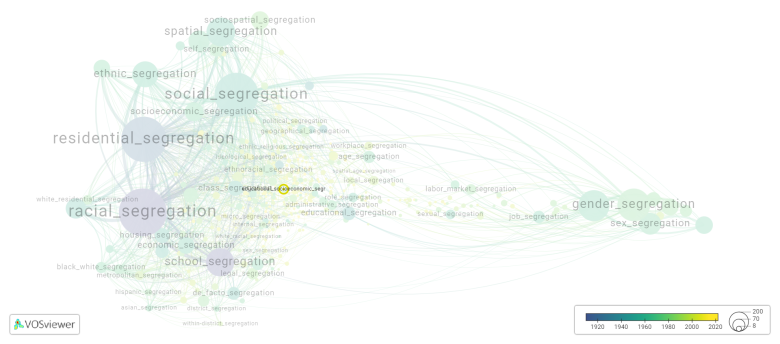Educational socioeconomic segregation: Difference between revisions
(Creating page) |
(Creating page) |
||
| Line 16: | Line 16: | ||
[[File:educational_socioeconomic_segregation.png|780x780px]] | [[File:educational_socioeconomic_segregation.png|780x780px]] | ||
Visualization based on the [[How_to_cite_Segregation_Wiki| research]] | |||
For the complete network of associated segregation forms, see: | For the complete network of associated segregation forms, see: | ||
year of publication https://tinyurl.com/2235lkhw | * First year of publication https://tinyurl.com/2235lkhw | ||
Louvain clusters https://tinyurl.com/2d8wg5n3 | * Louvain clusters https://tinyurl.com/2d8wg5n3 | ||
* Betweenness centrality https://tinyurl.com/223udk5r | |||
* Disciplines where segregation forms first appeared https://tinyurl.com/244d8unz | |||
==References== | ==References== | ||
==Notes== | ==Notes== | ||
Revision as of 13:40, 3 October 2024
Date and country of first publication[1]
2017
Chile
Definition
Educational socio-economic segregation refers to the division of students from different socio-economic backgrounds into separate educational institutions or tracks, leading to unequal opportunities and resources for learning. This segregation can manifest in various ways, such as through the allocation of funding, the quality of teachers and facilities, and the curriculum offered to students.
This type of segregation can have negative consequences for students from lower socio-economic backgrounds, as they may have limited access to high-quality education and resources that are essential for academic success. Additionally, the segregation can perpetuate cycles of poverty and inequality, as students from disadvantaged backgrounds may not have the same opportunities for social mobility as their wealthier peers.
Efforts to address educational socio-economic segregation may involve policies that promote diversity and inclusion in schools, increase funding for schools in disadvantaged communities, and provide additional support and resources for students from low-income families. By addressing these disparities, educational institutions can help create a more equitable and just society for all students.
See also
Related segregation forms
Educational socioeconomic segregation is frequently discussed in the literature with the following segregation forms:
social segregation, school segregation, residential segregation, socioeconomic segregation, school socioeconomic segregation

Visualization based on the research
For the complete network of associated segregation forms, see:
- First year of publication https://tinyurl.com/2235lkhw
- Louvain clusters https://tinyurl.com/2d8wg5n3
- Betweenness centrality https://tinyurl.com/223udk5r
- Disciplines where segregation forms first appeared https://tinyurl.com/244d8unz
References
Notes
- ↑ Date and country of first publication as informed by the Scopus database (December 2023).
At its current state, this definition has been generated by a Large Language Model (LLM) so far without review by an independent researcher or a member of the curating team of segregation experts that keep the Segregation Wiki online. While we strive for accuracy, we cannot guarantee its reliability, completeness and timeliness. Please use this content with caution and verify information as needed. Also, feel free to improve on the definition as you see fit, including the use of references and other informational resources. We value your input in enhancing the quality and accuracy of the definitions of segregation forms collectively offered in the Segregation Wiki ©.
Educational socioeconomic segregation appears in the following literature
Calquin C.C., Farris M., Patuelli K.R. (2017). Discussing school socioeconomic segregation in territorial terms: the differentiated influence of urban fragmentation and daily mobility; [Discutir la segregación socioeconómica escolar en términos territoriales. La influencia diferenciada de la fragmentación urbana y la movilidad cotidiana]. Investigaciones Geograficas, 2017(92), 34-50. Instituto de Geografia.https://doi.org/10.14350/rig.54766
